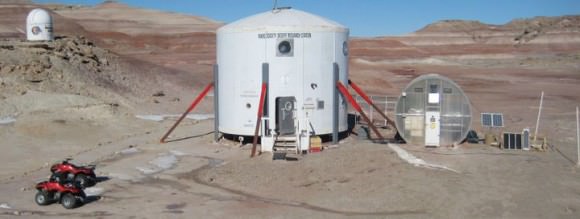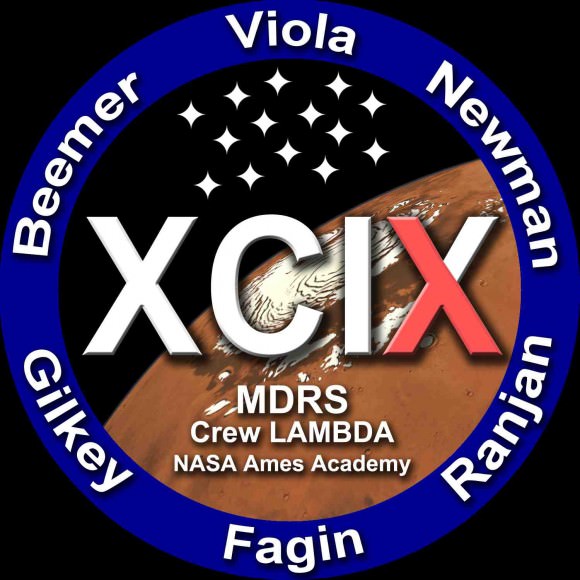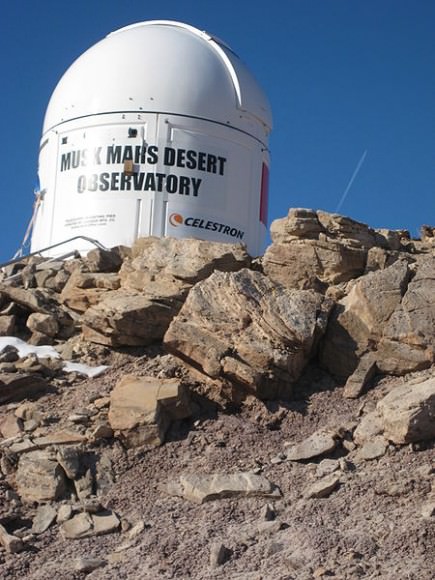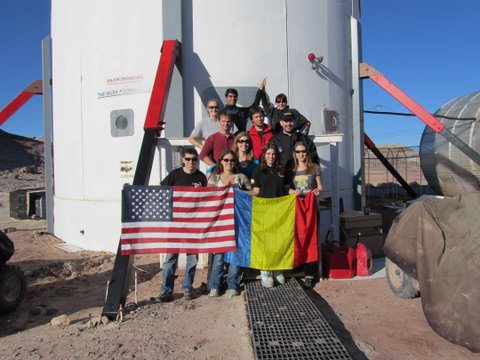[/caption]
Headline from the future? Actually, it’s happening now, although not quite on Mars, but about as close as humans can currently get. Six college students are the latest crew to embark on a two-week stint at the Mars Desert Research Station, a simulated Mars habitat set up by the Mars Society located in the San Rafael Swell of Utah. Looking across the very Mars-like red, rocky, panoramic vistas outside the habitat, participants might think they are on the Red Planet. And this latest crew, the 99th for MDRS, will be testing a microbial detection system and an EVA optimization method using an iPad.

The students — all graduate students or about to be – are from different colleges but came together in the summer of 2010 at the NASA Academy at the Ames Research Center in California, a 10-week immersive research internship.
“At the NASA Academy, we worked on a group project called LAMBDA – the Life and Microbial Detection Apparatus,” participant Max Fagin, from Dartmouth University, told Universe Today. “We wanted to do some follow-up work, in looking at microbial fuel cells, which run off the metabolic activity of bacteria — technology that could be applied to sewage reclamation plants in order to generate power.”
Fagin said the technology has been around a while, but they are trying to adapt it to detect microbes in soil samples, similar to what the Viking mission did in the 1970’s.
“We put a sample into the device and based on the power that is generated you can determine whether that power is coming from microbial activity or organic activity,” Fagin said.
They finished the summer internship with a good theoretical analysis and a non-working prototype, but wanted to field test their research, as well as continue work on other individual projects.

Donna Viola, a senior undergraduate at the University of Maryland, Baltimore County, had been on two crew rotations on the MDRS previously and suggested to her fellow NASA Academy team that they apply as a group to the MDRS where they could test LAMBDA in actual conditions, with actual soil samples in the field where there may be potentially extremophile forms of life to find.
The team was accepted and began their crew rotation at MDRS on January 29. They will be there until February 12, all the while in complete Mars simulation. Crew members must wear a space suit when going outside the Habitat; they eat only space-travel type food (along with vegetables grown on-site in a greenhouse); power is provided by batteries or a power generation system; and there is also a water recycling system.
Viola is the Commander, Heidi Beemer is the team geologist and Executive Commander, Kevin Newman is the Engineer, Andie Gilkey is the team scientist and Health and Safety Officer, Chief Biologist, Sukrit Ranjan is the team astronomer and Fagin is the EVA Engineer.
See the crew biographies.
14 students total were part of the NASA Ames Academy, and even though only 6 are at the MDRS, the rest are serving as ground and mission support.
The last six weeks the team has been updating the LAMBDA device and making it field worthy, integrating it with the control system, and testing it.
While at MDRS, the crew has a few other projects, such as working on a proposed combination EVA planner and EVA monitor that runs on an iPad. “It monitors the astronauts’ health, vital signs, how much energy they are consuming, whether they should speed up or slow down – it’s basically an EVA optimizer,” Fagin said.

They will also fly a payload on a high altitude balloon that tests the feasibility of using balloon borne payloads on Mars. “There are no FAA regulations on Mars, so on Mars you could build a weather station on a balloon – such as on a 10 km tether and reel it in and out to get very nice vertical cuts of the atmospheric profiles of wind velocity and direction and dust profiles,” Fagin explained. “And also you could do astronomy by launching a small telescope. But we can’t do the tether part because they are here on Earth so we’ll be using a balloon and have to retrieve it.” They will also be flying a generic meteorological payloads and doing astronomical projects at the observatory on site, the Musk Observatory, which has a 14-inch telescope.
During their stay, the crew is required to send daily reports and dispatches from the commander, engineers, crew scientists, and journalists through the MDRS website which provides updates on the status of science experiments, updates on crew health and morale, and on the habitat and how it is faring. There is also a live webcam of different parts of the station.
MDRS is the second research station to be built by the Mars Society. The first was the Arctic station (FMARS) on Devon Island, built in 2000. Stations to be built in Europe (European Mars Analog Research Station / Euro MARS) and Australia (Australia Mars Analog Research Station / MARS Oz) are currently in the planning stages.
The goal of these analog research stations is to develop key knowledge, field tactics and equipment needed to prepare for the human exploration of Mars, testing habitat design features and tools, and to assess crew selection protocols. Utah is much warmer than Mars, the desert location is optimal because of its Mars-like terrain and appearance.
Find out more information on participating in the MDRS.
The first dispatches from the LAMBDA crew report how they are getting acclimated to the habitat and the equipment, as well as preparing for doing their actual science research.
Fagin said without the NASA Academy at Ames, this group of students wouldn’t be together at the MDRS today.
“This grew out of everything we did at the NASA Academy,” he said. “Without those experiences we would have no idea how to approach the situation, wouldn’t understand the science or engineering that needs to go into such a project, and certainly wouldn’t have the team-working abilities to do this if we hadn’t developed them while we were at the NASA Academy.”
Learn more about the NASA Ames Academy.
Universe Today hopes to provide an update on the LAMBDA crew’s activities.


http://www.facebook.com/pages/Environmental-Club-University-of-Belize/101170129949465
Check out this page….the Environmental club of the University of Belize